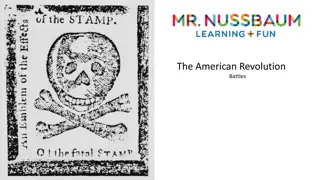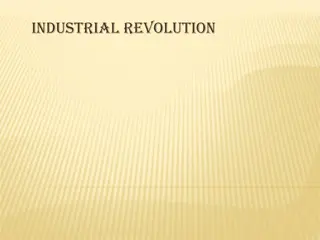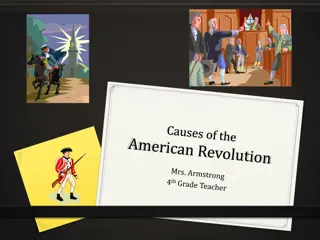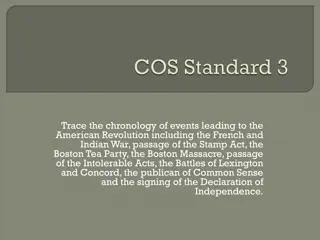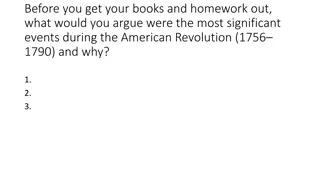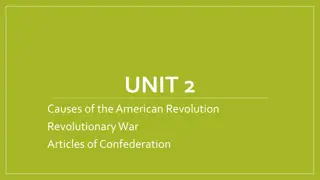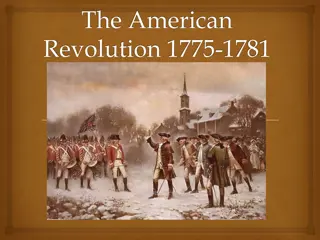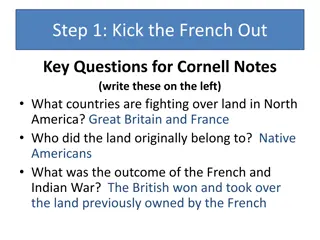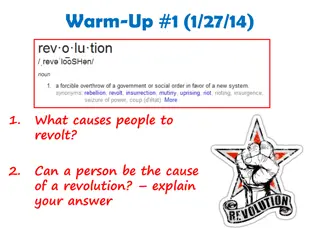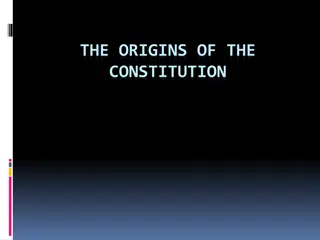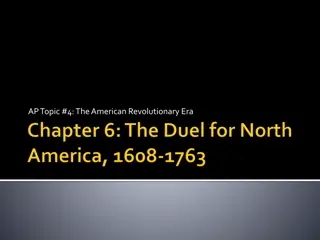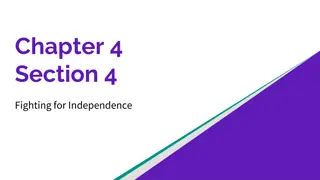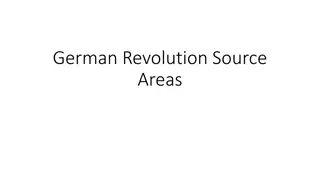Key Events Leading to the American Revolution
In preparation for an upcoming test, students are reminded to set a goal of achieving 70% or higher. They are provided with a handout to study key events such as the French and Indian War, Proclamation of 1763, Sugar Act, Stamp Act, and Quartering Act. The handout includes summaries of each event and their effects on the colonists, helping students understand the historical context leading to the American Revolution. Students are encouraged to study these events thoroughly for the test and turn in the handout for a redo grade.
Download Presentation

Please find below an Image/Link to download the presentation.
The content on the website is provided AS IS for your information and personal use only. It may not be sold, licensed, or shared on other websites without obtaining consent from the author.If you encounter any issues during the download, it is possible that the publisher has removed the file from their server.
You are allowed to download the files provided on this website for personal or commercial use, subject to the condition that they are used lawfully. All files are the property of their respective owners.
The content on the website is provided AS IS for your information and personal use only. It may not be sold, licensed, or shared on other websites without obtaining consent from the author.
E N D
Presentation Transcript
Jumpstart 10/22 Pick up your folder and a copy of the PDSA goal sheet. Our class goal is 70% for tomorrow s test. Set a goal for yourself (70% or above), then put this handout in the pocket of your folder. If you did not turn it in (most of you!), look for your American Revolution Cause and Effect Chain handout. For those of you who turned it in, this will be handed back to you. If you cannot find it, please ask for another copy. We re going to go back over this information today in order to make sure that everyone has correct information to study in preparation for the test tomorrow. You should use this handout to study as well as your pre-test then turn it in tomorrow for a redo grade. If you are going to finish the slideshow in class, you will only have about 3 minutes on each slide so copy everything you need down quickly. You may shorten what s on the slide some, but make sure you get the main ideas down so you have these to study and improve your grade when you turn it in.
French and Indian War SUMMARY: The French and their Indian allies fought the British and their colonists for control of the Ohio River Valley This led to EFFECT: Britain gained all of the land from the Atlantic Ocean to the Mississippi River (as well as Pontiac s Rebellion)
Proclamation of 1763 SUMMARY: Concerned about the cost of continuing to defend settlers from attacks by natives, King George III outlawed settlement west of the Appalachian Mountains This led to EFFECT: The colonists were angry because they d just fought and won a war to gain access to this land
Sugar Act SUMMARY: The Sugar Act reduced the tax on imported sugar, but increased enforcement of the tax This led to EFFECT: Samuel Adams organized protests, so the act was repealed; Colonists believe this is taxation without representation because the colonies were not consulted
Stamp Act SUMMARY: Parliament ordered that every public or legal document had to carry an official stamp (a form of fax) This led to EFFECT: Colonists held meetings, boycotted British goods, and even attacked British officials in protest; the British repealed the act
Quartering Act SUMMARY: An act of Parliament that required colonists to provide housing, bedding, food, drink, and supplies to British soldiers This led to EFFECT: When the New York assembly refused to obey the law, Britain dismissed the assembly.
Townshend Acts SUMMARY: Parliament introduced taxes on popular goods, including glass and lead. This led to EFFECT: Colonists held rallies and organized groups like the Sons of Liberty, as well as circulating pamphlets criticizing the new taxes
Boston Massacre SUMMARY: 4,000 British soldiers were stationed in Boston, leading to growing bitterness. This resulted in a confrontation that ended with five dead protesters. This led to EFFECT: Opponents of British rule used this tragedy to win public support against the British.
Tea Act SUMMARY: Parliament eliminated other taxes, but kept a small tax on tea as well as allowing the British East India Company to sell directly to colonists. This led to EFFECTS: Colonists refused to buy British tea because they believed it violated their right to conduct free enterprise and American tea merchants were angry.
Boston Tea Party SUMMARY: A group of colonists dumped 45 tons of tea into Boston Harbor. This led to EFFECT: The Boston Tea Party made the British government angry, leading to the Intolerable Acts.
Intolerable Acts SUMMARY: The acts closed Boston Harbor until the people of Boston paid for the lost tea, as well as eliminating self- government. This led to EFFECT: These acts greatly increased tensions between the colonists and Great Britain
Jumpstart 10/22 Pre-AP Turn in the Boston Tea Party 4 Square activity to the inbox. You will use the Unrest-O-Meter handout to help you complete today s activity. For those of you who turned in the Unrest-O- Meter, these are being handed back to you. For anyone who didn t turn in the Unrest-O- Meter, please find this in your folder QUICKLY. You will work in groups of four. You may choose your group and turn your desks to face each other, but YOU MUST TURN YOUR DESKS BACK LIKE THEY WERE before you leave because other classes are working independently today.
What Doesnt Fit DUE BEFORE YOUR QUIZ TOMORROW! Each printed slide consists of 5 pictures. FOUR of the pictures relates to one of the events/causes on your Unrest-O-Meter. ONE does not. Work with your group to do the following for each slide: First determine what event is being indicated on that slide. For instance, on Cause #1, there is (A) a bed, (B) New York, (C) a house, (D) Samuel Adams, and (E) a British soldier. Based on the bed and house alone, you might guess (correctly) that this is the Quartering Act. 1. Next, indicate which image doesn t fit and explain which event it is better matched to. Only a few of you made the connection between the Quartering Act and New York on your Unrest-O-Meter, but there is a connection. Samuel Adams doesn t fit here. He would be better matched to the Sugar Act (or maybe the Boston Tea Party). 2. Connect the other four images to the event. Write a sentence that shows the connection. Underline the images as you use them. For instance, The Quartering Act required colonists to provide housing and beds for British soldiers. When the New York assembly refused to follow the law, Britain dismissed the assembly. Hint: To make sure you finish in time, write down the identified images that fit then you can write your sentences connecting them outside of class if needed. 3.


